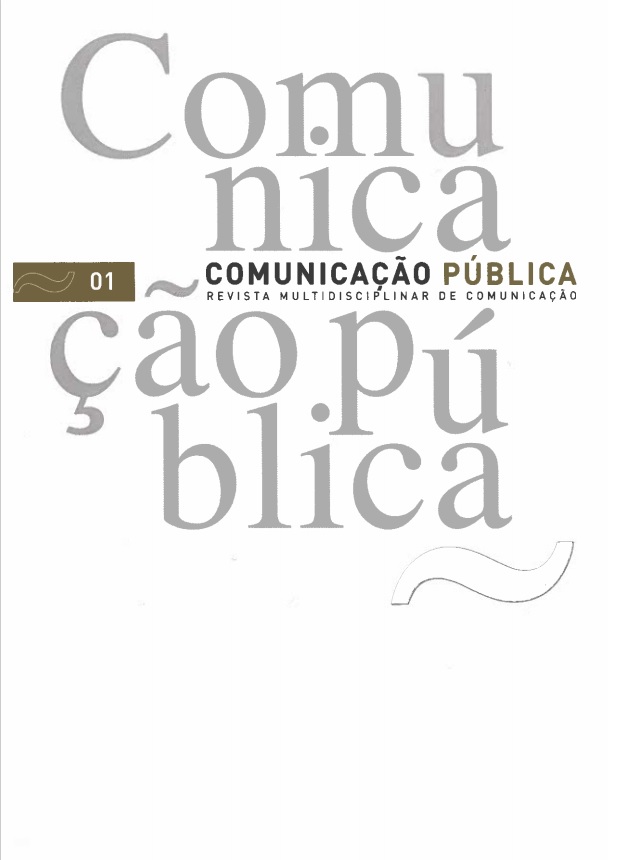Communication with macroeconomic impact
the public relations of the central bank
DOI:
https://doi.org/10.4000/cp.10053Keywords:
external communication, Central Bank, monetary policy, credibility, interest rates, inflation controlAbstract
Communicating with the public is essential for any organization. Its performance is certainly dependent on the way the several agents that relate to the organization understand the way in which it acts and tries to achieve their own goals. In this paper, the external communication process of an important economic institution is discussed. We are refering to the Central Bank – the Central Bank is responsible for the control of inflation; to guarantee price stability, this institution has to know how to manage expectations and the management of expectations is above all a process that is dependent on an effective and credible external communication.
Downloads
References
Barro, R. J. & Gordon, D. B. (1983) A positive theory of monetary policy in a natural rate model. Journal of political economy, vol. 91 (4), pp.589-610. DOI: https://doi.org/10.1086/261167
Benhabib, J.; Schmitt-Grohé, S. & Uribe, M. (2001a) The perils of Taylor rules. Journal of economic theory, vol. 96 (1), pp. 40-69. DOI: https://doi.org/10.2139/ssrn.171749
Benhabib, J.; Schmitt-Grohé, S. & Uribe, M. (2001b) Monetary policy and multiple equilibria. American economic review, vol. 91, March, pp. 167-185. DOI: https://doi.org/10.1257/aer.91.1.167
Benigno, P. & Woodford M. (2004) Optimal monetary and fiscal policy: a linear-quadratic approach. International finance discussion papers, nº 806, Bank of Governors of the Federal Reserve System. DOI: https://doi.org/10.17016/IFDP.2004.806
Bullard, J. & Mitra, K. (2002) Learning about monetary policy rules. Journal of monetary economics, vol. 49, pp. 1105-1129. DOI: https://doi.org/10.1016/S0304-3932(02)00144-7
Calvo, G. (1983) Staggered prices in a utility maximizing framework. Journal of monetary economics, vol. 12 (3), pp. 383-398. DOI: https://doi.org/10.1016/0304-3932(83)90060-0
Christiano, L. J. & Gust, C. J. (1999) Taylor rules in a limited participation model. NBER working paper, nº 7017. DOI: https://doi.org/10.3386/w7017
Clarida, R.; Galí, J. & Gertler, M. (1999) The science of monetary policy: a new keynesian perspective. Journal of economic literature, vol. 37, pp. 1661-1707. DOI: https://doi.org/10.1257/jel.37.4.1661
Clarida, R.; Galí, J. & Gertler, M. (2000) Monetary policy rules and macroeconomic stability: evidence and some theory. Quarterly journal of economics, vol. 115 (1), pp. 147-180. DOI: https://doi.org/10.1162/003355300554692
Galí, Jordi; Gerlach S.; Rotemberg J.; Uhlig H. e Woodford M. (2004) The monetary policy of the ECB reconsidered. Monitoring the European Central Bank 5. Londres, Centre for Economic Policy Research.
Giannoni, M. P. & Woodford, M. (2002) Optimal interest rate rules: I. General theory. NBER working paper, nº 9419. DOI: https://doi.org/10.3386/w9419
Kydland, F. E. & Prescott E. C. (1977) Rules rather than discretion: the inconsistency of optimal plans. Journal of political economy, vol. 85, pp. 473-491. DOI: https://doi.org/10.1086/260580
Miles, D. & Scott, A. (2002) Macroeconomics: understanding the wealth of nations. New York, John Wiley & Sons, Inc.
Roberts, J. M. (1995) New keynesian economics and the Phillips curve. Journal of money, Credit and Banking, vol 27 (4), pp. 975-984. DOI: https://doi.org/10.2307/2077783
Rogoff, K. (1985) The optimal degree of commitment to an intermediate monetary target. Quarterly journal of economics, vol. 100 (4), pp. 1169-1189. DOI: https://doi.org/10.2307/1885679
Rotemberg, J. J. & Woodford M. (1999) Interest rate rules in an estimated sticky-price model. In Taylor, J. ed. Monetary policy rules. Chicago University Press. DOI: https://doi.org/10.3386/w6618
Rudebusch, G. D. & Svensson, L. E. O. (1999) Policy Rules for inflation targeting. In Taylor, J. ed. Monetary policy rules. Chicago University Press.DOI: https://doi.org/10.3386/w6512
Svensson, L. E. O. (1999) Inflation targeting as a monetary policy rule. Journal of monetary economics, vol. 43, pp. 607-654. DOI: https://doi.org/10.1016/S0304-3932(99)00007-0
Svensson, L. E. O. (2002) What is wrong with Taylor rules? Using judgement in monetary policy through targeting rules. NBER working paper, nº 9421.
Taylor, J. B. (1993) Discretion versus rules in practice. Carnegie-Rochester series on public policy, vol. 39, pp. 195-214.
Taylor, J. B. (1999) Monetary policy rules. Chicago, Chicago University Press. DOI: https://doi.org/10.7208/chicago/9780226791265.001.0001
Walsh, C. E. (2003) Monetary theory and policy. 2ª ed., Cambridge, Massachussets, MIT Press.
Woodford, M. (1999) Optimal monetary policy inertia. NBER working paper, nº 7261. DOI: https://doi.org/10.1111/1467-9957.67.s1.1
Woodford, M. (2003) Interest and prices: foundations of a theory of monetary policy. Princeton, New Jersey, Princeton University Press. DOI: https://doi.org/10.1017/S1365100505040253
Published
Issue
Section
License
Copyright (c) 2005 Direitos de Autor (c) 2005

This work is licensed under a Creative Commons Attribution-NonCommercial 4.0 International License.
Os conteúdos da Comunicação Pública estão licenciados com uma licença Creative Commons - Atribuição-NãoComercial 4.0 Internacional.


